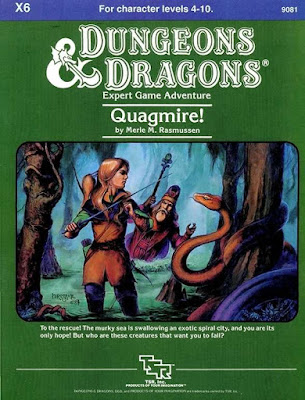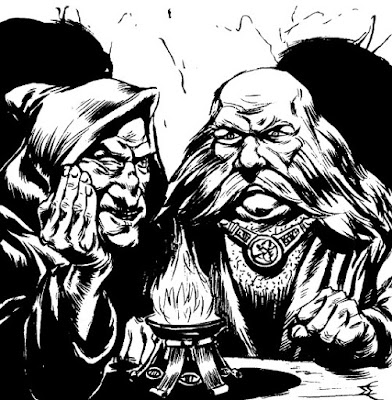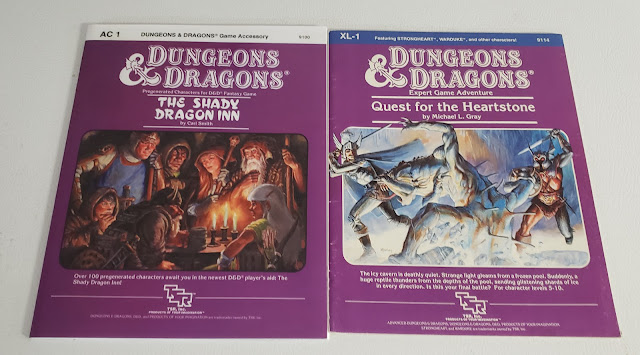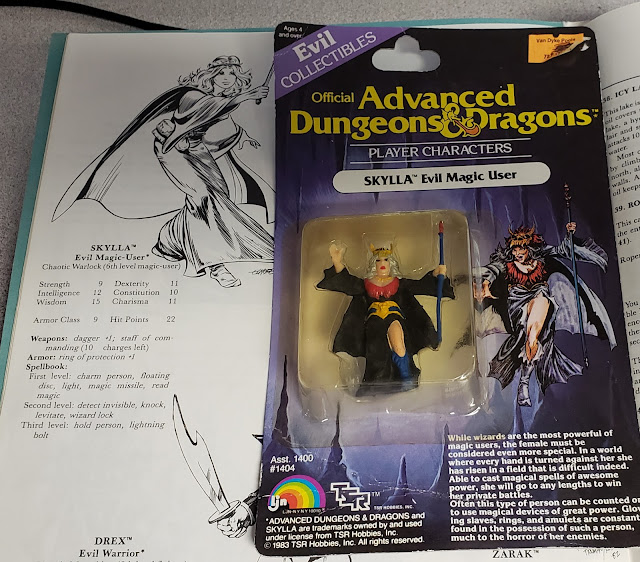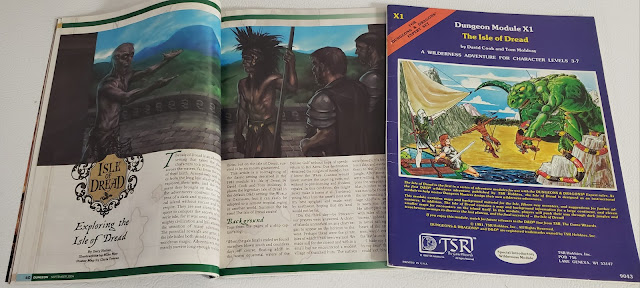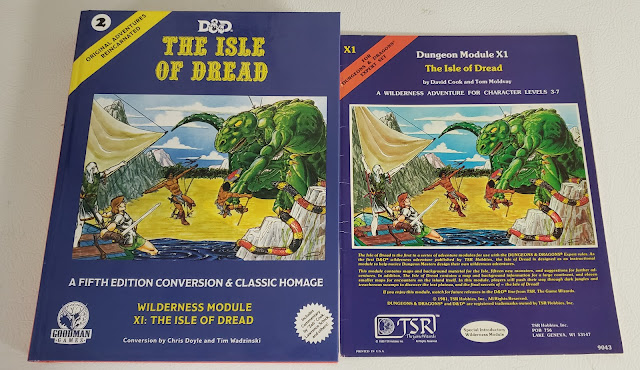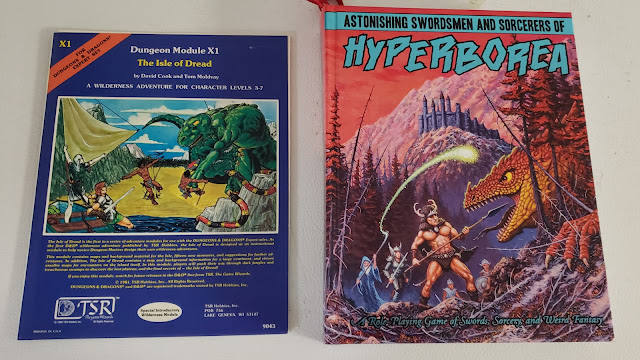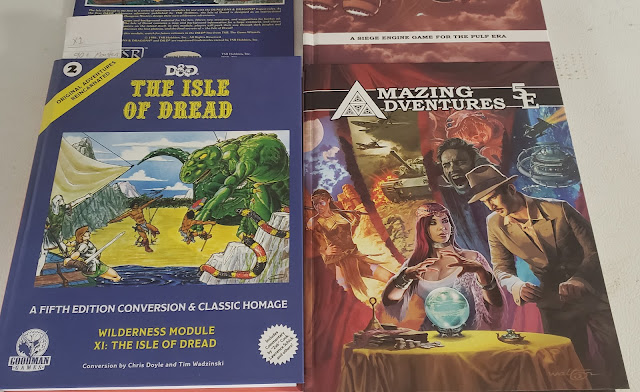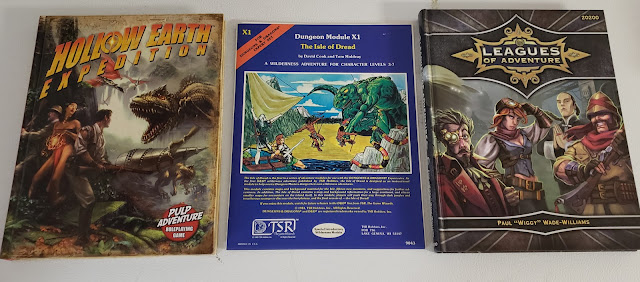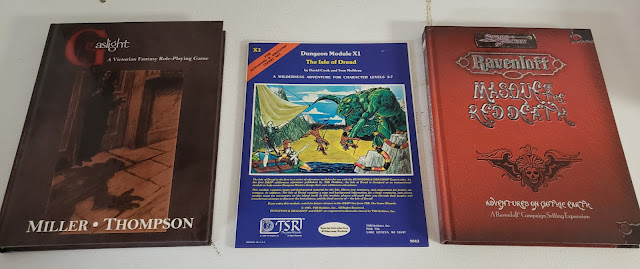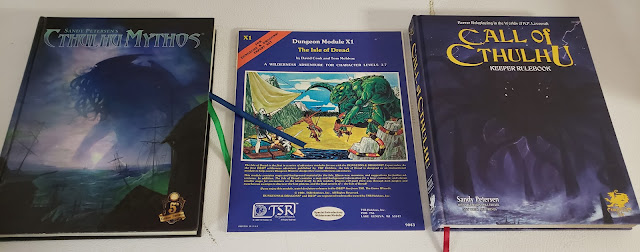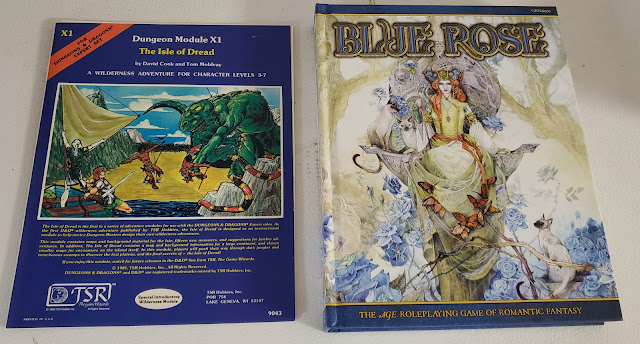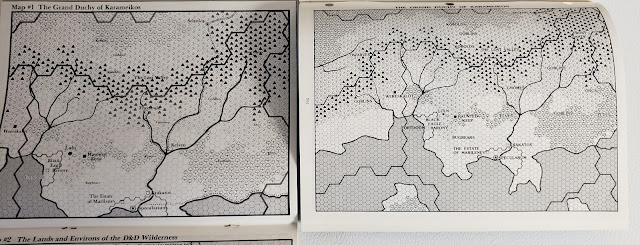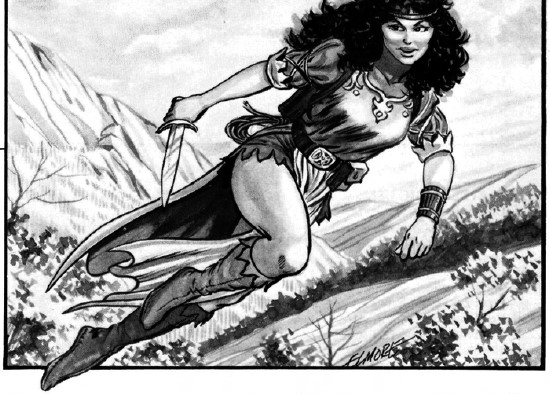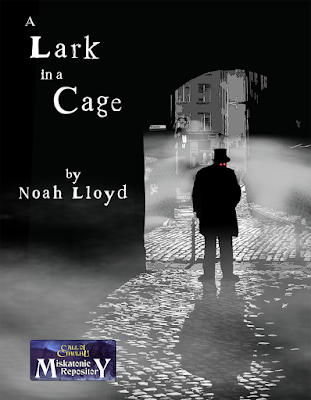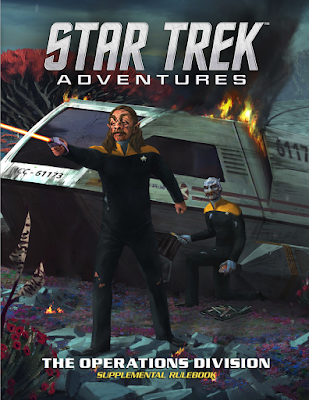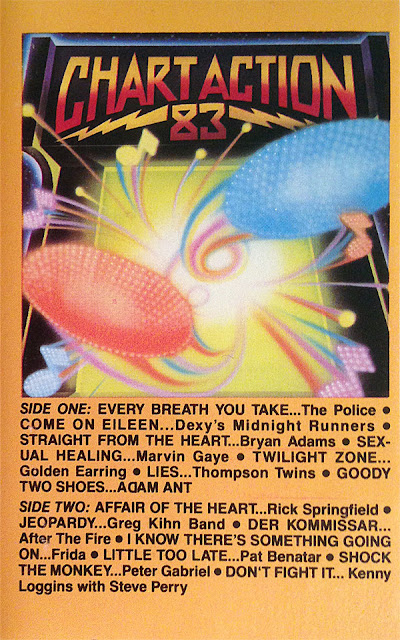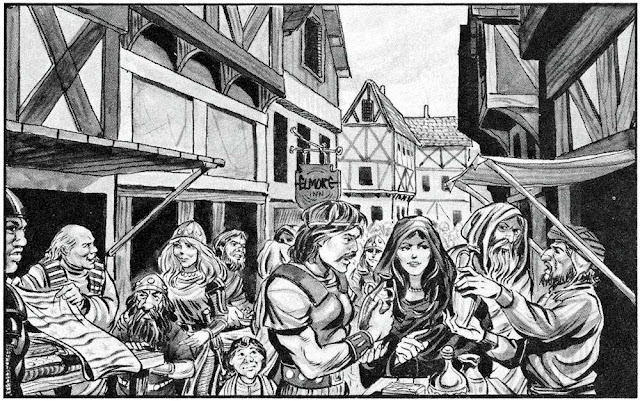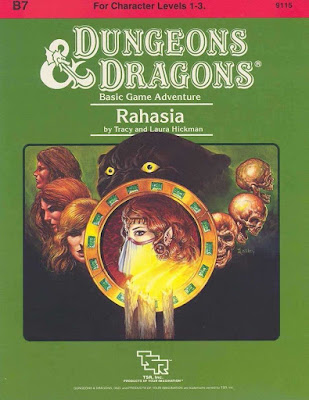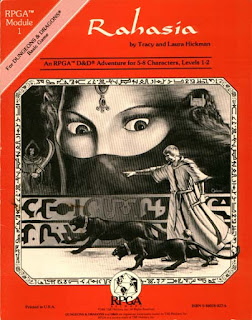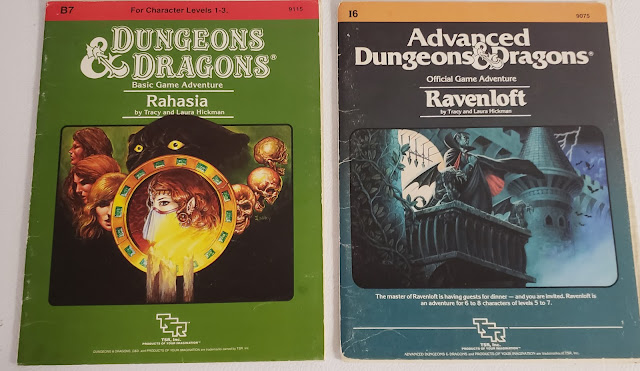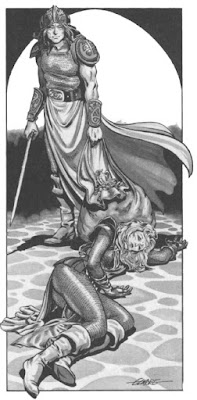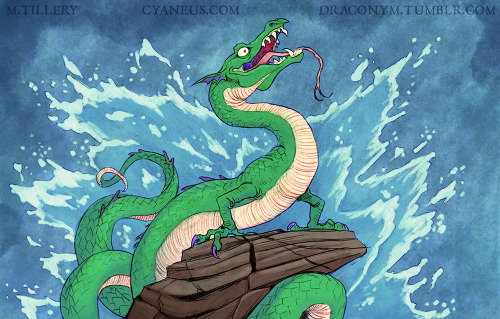Judge Dredd II
 Almost twenty years after Games Workshop gave us Judge Dredd: The Role-Playing Game, another British publisher gave us its take upon the infamous lawman of the future from the pages of the long-running Science Fiction comic, 2000AD. The year was 2002, publisher was Mongoose Publishing, and the rules employed the then system de jour—the d20 System. The Judge Dredd Role-Playing Game (notice the subtle shift of the determiner to differentiate between the two games) was the first of several roleplaying games that the publisher would bring out based on the 2000AD licence, the other most notable one being Sláine, The Roleplaying Game of Celtic Fantasy. Like that roleplaying game, The Judge Dredd Role-Playing Game was published as a full colour hardback which contained the means to play in its milieu. This is the year 2124 and just like the earlier Judge Dredd: The Role-Playing Game, this roleplaying game is set after a nuclear war which irradiated much of the Earth and forced most of the world’s population to live in a number of megalopolises—or supercities. Each is home to millions and millions living in great city-blocks, most of whom are unemployed and turn to hobbies, brand new trends or crazes, or even crime to keep themselves sane. The teeming masses are difficult to police and it takes a special dedicated individual, one who has trained for nearly all of his or her childhood to patrol and enforce the law in these great cities. These are the Judges, trained to be the best, armed with the best equipment, and ready to patrol the streets as combined policeman, judge, jury, and executioner. They enforce the law and do so fairly—and none no more fairly than Judge Dredd himself, a figure who is both authoritarian and an anti-hero, the most well known and feared Judge in Mega-City One on the eastern seaboard of what was once the United States of America. On a daily basis, Judge Dredd has to deal with litterers and jaywalkers, slowsters and sponts, robbers and murderers, smokers and boingers, illegal comic book dealers and gangster apes, and even Judge Death from a parallel earth. Over the years, the Judge Dredd comic has presented a carnival of crazy crimes and criminals, certainly more than enough to provide a rich, bonkers background, just as it did for Judge Dredd: The Role-Playing Game when it was published in 1985 and then again for The Judge Dredd Role-Playing Game when it was published in 2002.
Almost twenty years after Games Workshop gave us Judge Dredd: The Role-Playing Game, another British publisher gave us its take upon the infamous lawman of the future from the pages of the long-running Science Fiction comic, 2000AD. The year was 2002, publisher was Mongoose Publishing, and the rules employed the then system de jour—the d20 System. The Judge Dredd Role-Playing Game (notice the subtle shift of the determiner to differentiate between the two games) was the first of several roleplaying games that the publisher would bring out based on the 2000AD licence, the other most notable one being Sláine, The Roleplaying Game of Celtic Fantasy. Like that roleplaying game, The Judge Dredd Role-Playing Game was published as a full colour hardback which contained the means to play in its milieu. This is the year 2124 and just like the earlier Judge Dredd: The Role-Playing Game, this roleplaying game is set after a nuclear war which irradiated much of the Earth and forced most of the world’s population to live in a number of megalopolises—or supercities. Each is home to millions and millions living in great city-blocks, most of whom are unemployed and turn to hobbies, brand new trends or crazes, or even crime to keep themselves sane. The teeming masses are difficult to police and it takes a special dedicated individual, one who has trained for nearly all of his or her childhood to patrol and enforce the law in these great cities. These are the Judges, trained to be the best, armed with the best equipment, and ready to patrol the streets as combined policeman, judge, jury, and executioner. They enforce the law and do so fairly—and none no more fairly than Judge Dredd himself, a figure who is both authoritarian and an anti-hero, the most well known and feared Judge in Mega-City One on the eastern seaboard of what was once the United States of America. On a daily basis, Judge Dredd has to deal with litterers and jaywalkers, slowsters and sponts, robbers and murderers, smokers and boingers, illegal comic book dealers and gangster apes, and even Judge Death from a parallel earth. Over the years, the Judge Dredd comic has presented a carnival of crazy crimes and criminals, certainly more than enough to provide a rich, bonkers background, just as it did for Judge Dredd: The Role-Playing Game when it was published in 1985 and then again for The Judge Dredd Role-Playing Game when it was published in 2002.From the start, there is a hurdle to playing The Judge Dredd Role-Playing Game. This is the fact that it uses the d20 System and so requires access to the Player’s Handbook for Dungeons & Dragons, Third Edition. In fact, The Judge Dredd Role-Playing Game is a Class and Level, Feat and Skill roleplaying game. Now in 2002 this was not unusual and mechanically, several roleplaying games of the period were essentially supplements for the Player’s Handbook with extra rules and a background. That said, anyone familiar with the d20 System would be able to pick up The Judge Dredd Role-Playing Game, roll up a character, and get playing relatively quickly and without any great difficulties.
As per Judge Dredd: The Role-Playing Game, what the players can roleplay in The Judge Dredd Role-Playing Game are Judges, the lawmen of the twenty-second century. Two are presented as standard character Classes—the Street Judge and the Psi-Judge—with the Med-Judge, the Tek-Judge, the SJS Judge, and Wally Squad Judge presented as Prestige Classes. There are two major changes in comparison to standard Player Characters. One is that both the Street Judge and the Psi-Judge start at Third Level rather than First Level, the other is that the Street Judge rolls a twelve-sided die for Hit Points, whilst the Psi-Judge rolls an eight-sided die. As Human characters, Judges, both Street Judge and Psi-Judge, receive a bonus Feat at character creation, and they are given more Feats as they acquire Levels. They also gain more skill points in a similar fashion. These can be the Feats standard to the Player’s Handbook or those particular to The Judge Dredd Role-Playing Game.
Character creation is a straightforward process. A matter of rolling dice for attributes and Hit Points, then selecting skills and feats. These are a mix of standard skills and feats from the Player’s Handbook and those new in The Judge Dredd Role-Playing Game.
Judge Muller
Third Level Street Judge
STR 14 (+2) DEX 09 (-1) CON 10 (+0)
INT 15 (+2) WIS 11 (+0) CHR 13 (+1)
Defence Value: 10
Hit Points: 24
Base Attack Bonus: +3 (Melee: +5/Ranged: +3)
Fort Save: +3 Ref Save:+3 Will Save: +3
Skills: Balance 1, Bluff 1, Climb 3, Computer Use 4, Concentration 2, Drive 2, Intimidate 4, Jump 3, Knowledge (Law) 4, Listen 1, Medical 1, Pilot 1, Ride 1, Search 4, Sense Motive 3, Spot 2, Swim 3, Technical 4
Feats: Improved Interrogation, Lightning Reflexes, Luck of Grud
Weapon Proficiencies: All
The Psionics mechanics used for Psi-Judges can be best described as being a non-Vancian spell system. Instead of ‘fire-and-forget’ spells—or Psionic abilities—Psi-Judges possess Psi-Powers and receive several Power Points per day. This is in addition to Zero-Level Psi-Powers which a character can use several times per day. A Zero-Level Psi-Power like ‘Daze’ forces the target to lose his next action and costs a single Power Point to cost, whilst ‘Augury’, a Second-Level Psi-Power enables the Psionicist to cast his mind into the future to determine the outcome of an action. It costs two Power Points to cast. The Psionic Powers are a mix of new powers, such as ‘Psi-Lash’ or ‘Detect Thoughts’, and powers which feel familiar to spells from Dungeons & Dragons, like ‘Augury’ and ‘Clairvoyance’. The Psionicist also has access to Psionic Feats such as ‘Quicken Powers’, which enables a practitioner to manifest his psionic talents with a thought; normally it takes a Round to manifest a power. A psionic power can be saved against in a fashion similar to the spells cast by a Sorcerer.
Judge Garcia
Third Level Psi-Judge
STR 09 (-1) DEX 13 (+1) CON 12 (+1)
INT 16 (+2) WIS 15 (+2) CHR 18 (+4)
Defence Value: 11
Hit Points: 15
Base Attack Bonus: +3 (Melee: +4/Ranged: +2)
Fort Save: +4 Ref Save:+4 Will Save: +5
Power Points: 5
Psionic Talents: Zero-Level—Empathy, Missive; First-Level—Demoralise, Psychometry
Psionic Save: 14+Power Level
Skills: Balance 3, Bluff 6, Climb 0, Computer Use 3, Concentration 5, Drive 2, Intimidate 5, Jump 2, Knowledge (Law) 3, Listen 3, Medical 3, Pilot 2, Ride 2, Search 4, Sense Motive 4, Spot 4, Swim 0, Technical 3
Feats: Inner Strength, Psychoanalyst, Psychic Inquisitor
Weapon Proficiencies: All
Unfortunately, the mechanics for psionics are not very interesting, primarily because they are mapped onto the spell mechanics of the d20 System. This does not mean that they are unworkable, but rather that the results do not feel quite in keeping with that portrayed in the comic. The choice of Judges to play is also a potential issue, in that because Psi-Judge is a starting option, a team of Judges could conceivably consist of too many of them, their being weaker than Street Judges and less suited to street investigations. That said, an all Psi-Judge option is explored in the Game Master’s section. Another issue with the Judges as a play option is that a player cannot be a Med-Judge or a Tek-Judge right from the start rather than having to take a Prestige Class later on.
As well as presenting Judges as a play option, The Judge Dredd Role-Playing Game also offers another Class, not as a play option, but rather a campaign option. This is the Citizen Class, which notably lacks the training or abilities of the Street Judge or Psi-Judge, and starts at First Level rather than Third Level. To counter this, the Citizen is given a Prior-Life, such as Agitator, Cit-Def Soldier, Failed Cadet, Goon, Jetball Player, Juve, Mo-Pad Driver, Neo-Luddite, Punk, and more. The choices all neatly fit under the umbrella of the Citizen Class, whilst characters can aim for Prestige Classes such as the Assassin, the Bodyguard, the Citi-Def Officer, the Hunters Club Member, and more. This is potentially a fun idea and would make for a very different campaign to that of playing Judges.
Norma Trang
First Level Street Citizen
Prior Life: Agitator
STR 08 (-01) DEX 14 (+2) CON 08 (-1)
INT 12 (+1) WIS 12 (+1) CHR 16 (+3)
Defence Value: 12
Hit Points: 4
Base Attack Bonus: +0 (Melee: -1/Ranged: +2)
Fort Save: -1 Ref Save:+2 Will Save: +1
Skills: Bluff 6, Craze (Compulsive Eating) 6, Intimidate 6, Knowledge (Law) 6, Sense Motive 5
Feats: Iron Will, Fool Birdie
Weapon Proficiencies: Grenades, Pistols, Melee Weapons
The two character types—the Judges and the Citizens—lend themselves to very different campaign types. A Judge focused campaign will be about patrolling the streets, investigating crimes and mysteries, and apprehending perpetrators, and so on. It does not matter which roleplaying game you are playing based upon the ‘Judge Dredd’ comic strip, this is the default option. The option to play Citizens enables a campaign to become involved in Mega-City One daily life, for the Player Characters to get involved in and enjoy the rash Crazes which sweep the megalopolis, and then to go get involved in and commit crime! Initially though, this has to be on a small scale, to not come to the attention of any Judge, at least until they have acquired a few Levels, given the fact that even a basic Judge will be at least Third Level.
Another reason that Citizen characters will be at a disadvantage when facing any Judge is that the Judge will be superbly equipped, most obviously with the Lawgiver pistol and its wide range of ammunition types, and the Lawmaster motorcycle. To this are added further Judge equipment, such as the Birdie Lie Detector, Override Card, and Pollution Meter. A Citizen, or a Perp, might have a Double-Barrelled Stump Gun, General Arms Sg-1 XX, smoke bombs, lock hacker, and more, though unlike a Judge, a Citizen will have to pay for his equipment.
As with Judge Dredd: The Role-Playing Game, in terms of roleplaying, the Judges in The Judge Dredd Role-Playing Game are a bit one note, but then they are meant to be. That said, they are more skilled and capable, and focusing on different skills and choosing different Feats allows for some customisation and ensuring there are differences between Player Characters. That said, although they are neither as well equipped or as capable, Citizens can be anything and allow a player to roleplay free from the constraints placed upon a Judge.
Mechanically, The Judge Dredd Role-Playing Game uses the d20 System. So roll a twenty-sided die for any action and roll high to beat a particular Difficulty Class or Armour Class, that really is about it. The Judge Dredd Role-Playing Game of course includes rules for firearms combat and vehicle chases, and so on. Really, the only new mechanic in The Judge Dredd Role-Playing Game is that for a Judge making an arrest attempt and a perpetrator resisting the attempt with opposed Charisma rolls.
In terms of background, The Judge Dredd Role-Playing Game provides details about the Justice Department, which includes the resources and back-up a Judge can call upon, sentencing guidelines, stats and descriptions of Justice Department equipment and robots, and stats for sample Judges. Similarly, the ‘Life on the Streets’ chapter gives support for campaigns involving just Citizens, to be fair, primarily a number of Prestige Classes, but there are rules too for running street gangs, useful for a crime campaign. Both are supported by a guide to Mega-City One which covers its geography, government, habitats, infrastructure, sports, hobbies, crazes, and organisations, as well as regions beyond its walls. It is decent enough, though the selection of NPCs and perps is intentionally generic, so none of the Angel Gang, the mobster Uggie Apelino and the Ape Gang, the vigilante Blanche Tatum, the infamous Judge murderer, Whitey, or Judge Death. Such characters and criminals would of course be saved for the supplement, Mega-City One’s Most Wanted. On the plus side, this does mean that the Player Character Judges will be investigating and arresting perps of the Game Master’s own devising and building their own legends instead of emulating that of Judge Dredd himself, but on the downside, The Judge Dredd Role-Playing Game loses some of the flavour of the setting without them. A nice touch is that it is possible to play Ape characters, although they do not necessarily have to be gangsters.
Unfortunately, there is no beginning scenario for The Judge Dredd Role-Playing Game in the core rule book. That said, there is advice for the Game Master on running both Judge and Citizen campaigns, along with scenario ideas and campaign variants. This is decent enough and the Citizen campaign is certainly supported with supplements such as Rookie’s Guide to Criminal Organisations, Rookie’s Guide to the Block Wars, and The Rookie’s Guide to the Crazes.
Physically, The Judge Dredd Role-Playing Game is reasonably well written and comes as a full colour hardback, though calling it that is a slight stretch. Yes, colour is used throughout, literally just on the header, footer, and outside margin of nearly every page. And whilst there is artwork throughout taken from the comic strip, it is all black and white, all taken from the classic strips of the seventies and eighties, and much of it presented in too small a fashion to read with any ease and just so ever so slightly fuzzy. In all too many cases, when the artwork should pop out from the page, it simply fails to do so. That said, there are fantastically good full colour full page pieces in the book, though being towards the back of the book, do not really do a lot to support the game. For example, why are full colour illustrations of Justice Department equipment over a hundred pages away from their descriptions in the text?
So the question is, is The Judge Dredd Role-Playing Game any good? Well, simply put, no, it is not any good, but then neither is it any bad either. It could have been better facing towards the players and their characters by having the details about the Justice Department more upfront for the Judges, giving their players access to information about the back-up they could request and what sort of sentences they can hand out. It does give an alternative to Judge campaigns, the Citizen campaign, which could be a lot of fun. It does produce Judge characters who are at least competent and have skills and abilities, and the roleplaying game would go on to be supported by numerous supplements and scenarios. And yet, there are the mechanics. The problem is simply that The Judge Dredd Role-Playing Game uses the d20 System and whilst that works, it is just not that interesting. It definitely feels more as if the Judge Dredd setting has been shoehorned on to the d20 System and it does not feel quite like a natural fit.
There is no denying that a good game could be got out of The Judge Dredd Role-Playing Game, but in comparison to Games Workshop’s Judge Dredd: The Role-Playing Game, it lacks character—even though the Judge Dredd: The Role-Playing Game is not a great design mechanically—and feels as it demands more effort upon both player and Game Master. Overall, The Judge Dredd Role-Playing Game is solid, serviceable, and supported, but its inherent blandness means it lacks that certain something which makes you want to play it.
